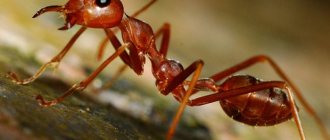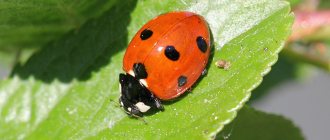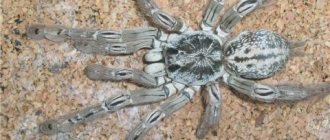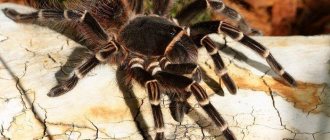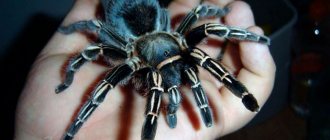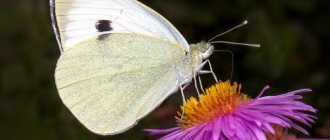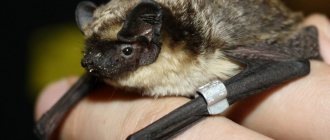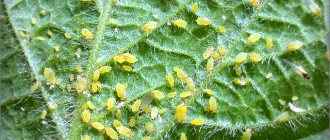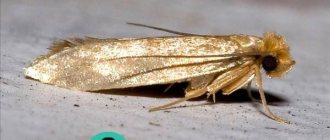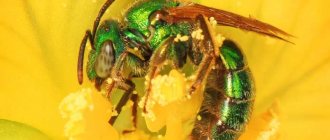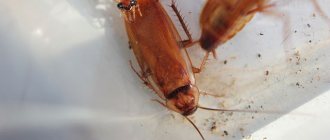The request for "Ladybug" is redirected here; see also other meanings.
Ladybugs, or coccinellids (lat. Coccinellidae), are a family of beetles. The body of these beetles is convex, round or oval. They are clearly visible due to their bright “warning” color[1], represented by various combinations of red, yellow, white and black, mainly with black spots on a main light background, less often – vice versa. Body length is from 0.8 to 18 mm, usually 4-7 mm. When disturbed, the beetles secrete droplets of caustic orange hemolymph from the knee joints, making them inedible for most insectivorous vertebrates. Ladybugs and their larvae are predators that feed on aphids, mealybugs and other small insects; few species are herbivorous. The family includes about 6,000 species. Distributed almost throughout the globe, with the exception of Antarctica and permafrost zones.
Description[edit | edit code]
Small beetles with a body length from 0.8 (genus Carinodua) to 18 mm (genus Megalocaria)[2]. The body is oval or round-oval in shape, strongly convex at the top, almost hemispherical or ovoid. The underside of the body is almost flat or slightly convex. Some groups of ladybugs have an oblong-oval body, flattened to one degree or another. The surface of the body is predominantly bare - without hairs and bristles, less often covered with small hairs. The head is short, small in size, and can be elongated in the longitudinal or transverse direction. The eyes are large, often with a notch on the anterior edge. The antennae are of varying lengths, sometimes longer than the head, consist of 8-11 segments, are attached to the sides of the anterior edge of the head and are capable of bending under the head. The end of the antenna is sharply expanded and forms a thickening - a club. The shape of the last and penultimate segments of the antennal club is different in different genera, which is taken into account when identifying species. The mouthparts are gnawing type. The upper jaws are massive, sickle-shaped. In herbivorous species (subfamily Epilachinae), they have numerous teeth at the apex. In predatory species and those that feed on fungi and pollen (subfamily Coccinellinae), the upper jaws have two sharp teeth at the apex. The lower lip is elongated, less often transverse[3].
Types of ladybugs, photos and names
Zoologists identify 4,000 different species of ladybugs, divided into 7 subfamilies. We will describe the most interesting among them.
Two-spot ladybird
This is a beetle with a body length of up to 5 mm, with a dark red body and two black dots (hence the name).
Seven-spotted ladybird
It is this type of ladybug that is most common in Europe. Its size is 7-8 mm. Its elytra are painted red, there are three black spots on the sides, and the seventh is located near the head of the insect.
Twelve-spotted ladybug
This ladybug has a length of 6 mm, a bright pink or red color, and, accordingly, 12 black spots on the elytra.
Thirteen-spotted ladybird
This type of ladybug has as many as 13 spots against the background of red-brown elytra; some of its spots can merge with each other.
Asian ladybug
This ladybird is up to 7 mm long and is divided into two subspecies. One of them has a yellow wing cover with black spots, both large and small. The second subspecies is characterized by black coloration of the elytra, on which red-orange spots are visible.
Ocellated ladybird
This is a very large representative of the ladybird family, reaching up to 10 mm in length. It has red or yellow elytra and black spots surrounded by lighter rims.
Pointless ladybug
This is a very rare species; its characteristic feature is the absence of signature spots. Also, the red or brown body of the pointless ladybug is covered with small fibers.
Blue ladybug
This is another unusual member of the ladybug family, having a characteristic blue color. Such insects live exclusively in Australia.
Larvae[edit | edit code]
Coccinellid larvae belong to the campodeoid type - they are mobile, have an elongated body and three pairs of long thoracic legs. The appearance of the larvae of members of the family is very diverse. The larvae of most Palaearctic species belong to the so-called coccinelloid type, which is characterized by a fusiform body shape, a large head and long legs[3].
The head of the larvae is rounded and quadrangular, approximately the same width and length. Its sides are rounded to one degree or another or straight. There are antennae on the head. Two-segmented and single-segmented antennae are characteristic of specialized genera that feed on pseudoscale insects. Variations in the structure of the antennae are represented by a combination of different lengths of the basal and apical segments (genus Hyperaspis, Nephus). The mandibles of the larvae are triangular or sickle-shaped, protruding or slightly protruding. Mandibles according to their structure can be divided into 2 types. The first - multi-toothed, triangular in shape, with an absent retinacula - are characteristic of species (Subcoccinella) with a herbivorous lifestyle. Mandibles of the second type are characteristic of Coccinellinae; they are sickle-shaped, have 1-2 sharp teeth at the apex, and the retinacula is developed. There are three simple eyes on the sides of the head. The abdomen is 10-segmented, without caudal filaments at the end. The legs are long, wider than the body. The dorsum has various structures, armed with setae, or covered with white waxy threads[3].
The prothorax is much longer and narrower than the mesothorax and metathorax. The dorsum of the prothorax has 2 or 4, rarely 6 scutes - square, rounded-square or elongated, placed longitudinally. The dorsum of the mesothorax and metathorax have 2 scutes of an oval oblong, less often round shape, located across the segments. On their outer edges the scutes are covered with various setae.
Legs are elongated. The abdomen is formed by 10 segments, the last of which is shifted to the ventral side and has the shape of a sucker. The tergite of segment IX is most often rounded at its apex, sometimes with a cone-shaped or triangular outgrowth. The integumentary formations on the abdomen of larvae are extremely diverse and can be used as important taxonomic characters. They are represented by: warts, outgrowths of various shapes and bristles.
The larvae go through four instars. Larvae of the first instar are small in size, length from 0.5 to 1.2-1.7 mm. At the fourth instar, the length of the larvae is 5-8 mm, and some – 17-18 mm. Larvae of the first instar usually have a single color - dark or gray with white, yellow, orange or red spots. At older ages, the larvae acquire bright and varied colors. Bright coloring is characteristic, as a rule, of species that feed on aphids and live openly in their colonies. There is a relationship between coloring and their behavior: the more active the larvae, the brighter the color (the genera Coccinella, Coccinula, Anatis, Harmonia axyridis, Aiolocaria mirabilis, with a contrasting combination of rich black color with orange spots and stripes). Single-colored, often dark larvae are characteristic of ladybugs that feed on pseudoscale insects[3]. The color of the larvae is subject to age and individual variability.
Beetles and larvae of most species are entomophagous predators. Only a few species feed on plant foods[3].
Biology and ecology[edit | edit code]
Most species are confined to certain landscape and geographical zones, and each of them is usually characterized by a special complex of species. However, some species are polyzonal, for example, Coccinella septempunctata, Coccinella undecimpunctata, Adonia variegata. Species of the family are characterized by attachment to certain vegetation. Some of them live mainly on trees (Adalia bipunctata, Oenopia conglobata), others on herbaceous vegetation (Propylaea quatuordecimpunctata, Adonia variegata, Coccinula quatuordecimpustulata), and others on vegetation of any type (Coccinella septempunctata, Psyllobora vigintiduopunctata).
It is considered a beneficial insect because it eats aphids and coccids. However, some species, such as Epilachna varivestis, are herbivores. In winter, ladybugs gather in clusters under fallen leaves, under the bark of trees or stones and wait there for the arrival of spring. Clustering helps maintain temperatures above ambient.[4] Depending on the availability of food, these insects live from several months to a year, and very rarely - up to two years. Young individuals are always distinguished by their bright coloring, which gradually fades with age, while remaining a fairly convincing warning for predators who want to encroach on the life of the insect.
How do ladybugs reproduce? Stages of ladybug development.
Ladybugs reach sexual maturity, depending on the species, at 3-6 months of life. Their mating season begins in the spring. The male finds his chosen one by the characteristic smell that she emits during that period. A short time after mating, the female ladybug lays eggs, and often acts very wisely, laying them near aphid colonies in order to immediately provide future offspring with food.
Ladybug eggs are attached to the underside of the leaves; they are oval in shape with slightly tapered ends. There are up to 400 eggs in one clutch. Unfortunately, the females themselves die soon after laying eggs.
After 1-2 weeks, variegated ladybug larvae emerge from the eggs. They have an oval or flat shape. The surface of the larva's body is often covered with thin bristles or hairs. In the first days of their lives, they eat the shell of the egg from which they hatched, then neighboring eggs without or even with embryos (yes, ladybug larvae can be cannibals). Gradually gaining strength, they begin to eat the aphid colony.
The future ladybug remains in the larval state for 4-7 weeks, after which the pupation stage begins. The pupa is attached to a leaf of the plant and in this position, in the cocoon, spends 7-10 days; it is during this period that all body parts characteristic of a cow are formed. After this period, a fully formed adult appears.
Economic significance[edit | edit code]
Ladybugs are among the effective entomophagous insects: they destroy many crop pests and are of significant interest for the development of a biological method of controlling them.
Herbivorous species (phytophagous) are distributed mainly in countries with warm climates, some of them are pests of agricultural crops, including the bean beetle in Mexico and the potato ladybird in the Oriental region. Three herbivorous species of ladybirds of economic importance live on the territory of the CIS countries: Subcoccinella vigintiquatuorpunctata (alfalfa twenty-four-spot), Henosepilachna vigintioctomaculata, Henosepilachna chrysomelina. The species Henosepilachna vigintioctomaculata is widespread in the Far East, as well as in Korea, Japan, and China, where it damages potatoes and other nightshades, as well as melons. In this area, the species is one of the primary pests of potatoes, not inferior to the Colorado potato beetle. Henosepilachna chrysomelina is common in Central Asia and can damage melons and melons. In the southern regions of Russia, the alfalfa moth (Subcoccinella vigintiquatuorpunctata L.) sometimes damages alfalfa and sugar beet plantings. In Smolensk, Saratov and other regions of central and southern Russia, the pointless ladybird (Cynegetis impunctata L.) occasionally damages alfalfa, clover and sweet clover. Bulaea lichatschovi in Central Asia and Kazakhstan is considered a potential pest of sugar beets[5].
Area and habitats[edit | edit code]
More than 8,000 species of ladybugs are known, which are distributed in all parts of the world[9]. Some of them are found on all plants: trees, shrubs or grasses that only have aphids; others live only on field grasses; still others - in meadows adjacent to streams; fourth - only on trees; finally, some species live on reeds and other aquatic plants; the latter are distinguished by longer legs, which help them stay on plants that bend easily from the wind.
Classification[edit | edit code]
The ladybird family includes about 360 genera. Here are just a few of them:
- Adalia – with the species Two-spotted ladybird (Adalia bipunctata)
- Coccinellatypus
- Coccinula
- Harmonia
- Hippodamia
- Propylea
- Psyllobora
- Rhyzobius
- Scymnus
- Tytthaspis
What do ladybugs eat?
Ladybugs eat soft-bodied insect pests such as aphids, mealybugs, thrips, whiteflies and mites.
Sometimes they feed on the eggs or larvae of other beetles. Both larvae and adult ladybugs are voracious, consuming hundreds of pests per day.
They also feed on pollen and can help pollinate plants, but beneficial ladybugs do not eat plant leaves.
Why are ladybugs good for your garden?
The presence of ladybugs is a sign of a healthy garden! Since they prey on many common insect pests, having them in your yard will help prevent or get rid of them.
Ladybugs help eliminate pests and control their populations.
Etymology[edit | edit code]
- The most common variant of the name ladybug indicates livestock belonging to a god or some divine character: rus. ladybug, polish biedronka, lit. boružėlė, Serbo-Croatian bozhja òvčica, fr. bête à bon Dieu ("animal of God"), poulette à Dieu ("hen of God").
- Folklorist S.Z. Agranovich, based on the works of linguist V.N. Toporov, suggests that the Slavs associated the ladybug with Mokosh, the goddess of earth and fertility. Thus, the common saying: “Ladybug, fly to heaven, bring me bread, black and white - just not burnt” is interpreted as a request to the goddess for a harvest. At the same time, the indication that the bread can be burnt refers, according to researchers, on the one hand to the black dots on the elytra of insects, and on the other hand to the myth of the murder and dismemberment of Veles by the thunder god Perun[11].
- In English-speaking countries, the ladybug is called English. ladybird, English ladybug or English lady beetle. The word that unites these names is English. Lady implies the Virgin Mary. Also in Catholic countries, the ladybug is considered the insect of the Mother of God (cf. German Marienkäfer, Spanish mariquita).[12] One of the ancient names for the beetle in the German language was Old German. Freyafugle, bird of the goddess Freya. With the Christianization of culture, Freya was replaced by the Virgin Mary. In Dutch the beetle was called niderl. Ingetsje (little angel), Dutch. Hemelbeestje (god's creation); at the moment his name is niderl. Lieveheersbeestje (Creation of our Righteous God). In German, the modern name is German. Marienkäfer (Mary's beetle).[13]
- Killing a ladybug is prohibited in some cultures. The ladybug is considered a symbol of good luck in Western culture.[14]
How and with what to attract ladybugs to your summer cottage?
Ladybugs, also called St. Mary's beetles, are one of the most useful insects in the garden. The ladybug itself and its larva are very voracious, they destroy thousands of aphids, whiteflies, scale insects, mites, and scale insects. Therefore, it is necessary to attract ladybugs into the garden and create suitable conditions for them there for development and overwintering.
In some countries, ladybugs are bred for sale to gardeners. The ladybug larva resembles a worm, but it has 6 legs and is black or bluish-blue with orange stripes. The ladybug is a predator, but there are species that feed on nectar. The coloring of a ladybug warns birds of danger and they do not touch it.
How to attract ladybugs into your garden?
Read also: Which European country grows large quantities of hops?
1) You can catch and bring ladybugs and their larvae into the garden.
2) Under no circumstances use insecticides that destroy both harmful and beneficial insects.
3) Plant the following plants in the garden to attract ladybugs: dill, angelica, yarrow, tansy, some dandelions, buckwheat, sweet clover, navel, elderberry bush (attracts aphids).
4) Use artificial food “Wheast”.
5) Use of ferramone baits (attractants).
6) Create suitable conditions for overwintering. For this purpose, they buy or make themselves special houses for ladybugs, in which there are holes and shavings, bark, and dry leaves are placed. They need to be placed closer to the ground for better overwintering of ladybugs. Here are several houses made of wood, logs, and plastic.
Notes[edit | edit code]
- ↑ Savoyskaya G.I. Coccinellids (systematics, application in the fight against agricultural pests). Alma-Ata, publishing house "Science" of the Kazakh SSR, 1983. 248 p.
- ↑ Seago, A.E.; Giorgi, J. A.; Li, J.; Ślipińskia, A. Phylogeny, classification and evolution of ladybird beetles (Coleoptera: Coccinellidae) based on simultaneous analysis of molecular and morphological data (English) // Molecular Phylogenetics and Evolution : journal. – Academic Press, 2011. – July (vol. 60, no. 1). – P. 137-151. – doi:10.1016/j.ympev.2011.03.015. – PMID 21426943.
- ↑ 1 2 3 4 5 6 7 8 9 Khabibullin V.F., Stepanova R.K., Khabibullin A.F. Ladybugs (Coleoptera: Coccinellidae) of the Republic of Bashkortostan. - Ufa: RIO BashSU, 2004. - 110 p.
- ↑ Ecology and Behavior of the Ladybird Beetles (Coccinellidae), p. 311.
- ↑ Avoyskaya G.I. Coccinellids: Systematics, application in the fight against agricultural pests. Alma-Ata: Science, 1983-247 p.
- ↑ Red Book species Aiolocaria hexaspilota in the Red Book of the Trans-Baikal Territory. oopt.aari.ru. Date accessed: October 25, 2019.
- ↑ Anonymous common name: ladybirds, ladybird beetles, lady beetles, ladybugs (of Florida). Featured creatures. University of Florida. Access date: April 8, 2010.
- ↑ Crowe A. (2002). Which New Zealand Insect?. Auckland, NZ: Penguin. p. 47. ISBN 0-14-100636-6
- ↑ Seago, Ainsley E.; Giorgi, Jose Adriano; Li, Jiahui; Slipinski, Adam. Phylogeny, classification and evolution of ladybird beetles (Coleoptera: Coccinellidae) based on simultaneous analysis of molecular and morphological data (English) // Molecular Phylogenetics and Evolution : journal. – Academic Press, 2011. – March 15 (vol. 60). – P. 137-151. – doi:10.1016/j.ympev.2011.03.015. – PMID 21426943.
- ↑ A. G. KIREJTSHUK & A. NEL. The oldest representatives of the family Coccinellidae (Coleoptera: Polyphaga) from the Lowermost Eocene Oise amber (France) // ZOOSYSTEMATICA ROSSICA. – 2012. – P. 131-144.
- ↑ Agranovich, SZ (Sofʹi︠a︡ Zalmanovna). Homo amphibolos = Chelovek dvusmyslennyĭ : arkheologii︠a︡ soznanii︠a︡. – Samara: Izd. Dom “Bakhrakh-M”, 2005. – 343 pages p. – ISBN 5946480324.
- ↑ Bishop Barnaby (English) // Notes and Queries (English) Russian. : journal. – 1849. – 29 December (vol. 9).
- ↑ Sam Segal, Clara Allen. Dutch and Flemish Flower Pieces. – T. I. – P. 79. – ISBN 978-90-04-42745-7.
- ↑ What the ladybug warns about, signs.
Links[edit | edit code]
- Ladybugs // Encyclopedic Dictionary of Brockhaus and Efron: in 86 volumes (82 volumes and 4 additional). – St. Petersburg, 1890-1907.
- P. V. Semyanov Family Coccinellidae - ladybugs or coccinellids (including Epilachninae).
- Sergei Sergeevich Izhevsky. Ladybug.
- Atlas of ladybugs (Coccinellidae) of Russia.
- (English) Ladybug in Australia. Archived November 30, 2012.
- (English) Multicolored Asian ladybug Harmonia axyridis Photos of ladybugs. Archived November 30, 2012.
- (English) Article about ladybugs on The Earth Life Web. Archived November 30, 2012.
- (English) Harlequin Ladybird survey in the British Isles. Archived November 30, 2012.
- (English) Basic information about ladybugs (Ladybugs of Asia). Archived November 30, 2012.
- (English) Ladybugs. Archived November 30, 2012. on the UV/IFAS Featured Creatures Web site
Source
